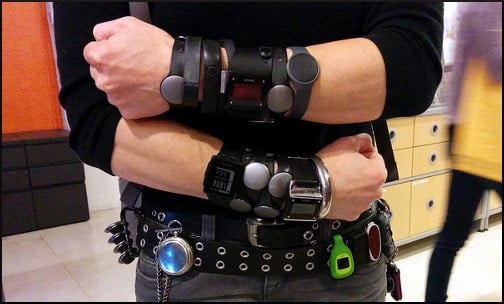
Inventors have utilized technology to monitor biological processes in an astonishing number of ways, but we usually envision the gadgets as being employed one at a time. Bucking that trend, a data scientist from Stanford University holds the world record for the highest number of continuously-worn wearable sensors.
For period of time, neuroscientist Rachel Kalmar always had at least 10 devices attached to her body, and the total has gone as high as 38 simultaneously active sensors recording her vital signs and more. One of her goals was the achievement of maximal interactivity. Another was to confirm that the various sensors assigned to capture the same data were actually performing that function.
If one device says a person’s temperature is 98.6 degrees and another says 106, obviously this discrepancy needs looking into. Kalmar says:
I wanted to try out all the activity trackers and get a sense of how the data compared, and what I liked about which ones, how the data compared within a wearing position, and across wearing positions… How does the data coming from your ankle differ from the data from our waist?
She learned that there are built-in technical barriers to downloading and comparing the collected numbers. Devices have limitations. Maybe the gadget can count steps, but what if the person is biking or swimming?
Can the gadget be taught to meaningfully compare apples and oranges? Kalmar learned this succinct wisdom:
There’s a tradeoff between “How smart do you want your algorithms to be?” and “How long do you want your battery to last?”
On a more meta level, she came to understand that everyday, non-geekish sorts of people have little appetite for raw data, because they don’t know what to make of it. It became apparent that tons of raw data are not worth much, unless the material is transmogrified into comprehensible and actionable information.
Also, that information has to be conveyed to its destination uncorrupted, and in a timely fashion. Kalmar wants to create…
[…] some kind of app or product or service that sits on top of incoming data, and ideally can propagate value back to the device makers too… Things that use data to do things that we’ve authorized them to do, to help solve problems that we don’t even realize are problems…
A recent paper about smart device-based notifications is lengthy, detailed, and opens several areas of speculation and possibilities to the curious. Perhaps the most jaw-dropping feature of this paper is Table A1, a list of almost 90 electronic items that the researchers reviewed.
Just to appreciate the variety and versatility of the field, here are some of smart devices that exist as of now: wireless breathalyzer, blood glucose meter, baby monitor, health tracker, intelligent yoga mat, fitness tracker, nest cam, wearable for kids, portable fish finder, wireless blood pressure monitor, fitness band, digital video monitor with night vision, pet activity tracker, intelligent bracelet, virtual reality headset, button controller, wearable communication device, ring, firewall, programmable dash button, wireless music receiver, thinking music player, air quality monitor, pool cleaning robot, propane tank gauge, thermometer, herb garden, gesture control, home energy manager, smoke alarm battery, sprinkler automator.
Few of these items relate to obesity or even health, and few are wearable, but they are scrutinized by open-minded scientists who peer under every rock in search of a fact or connection that will spark some marvelous new invention.
Your responses and feedback are welcome!
Source: “Rachel Kalmar on Data Ecosystems,” SoundCloud.com, 2017
Source: “Smart Device-Based Notifications to Promote Healthy Behavior Related to Childhood Obesity and Overweight,” MDPI.com, 01/18/18
Photo credit: Cory Doctorow (gruntzooki) on Visualhunt/CC BY-SA

 FAQs and Media Requests:
FAQs and Media Requests: 











